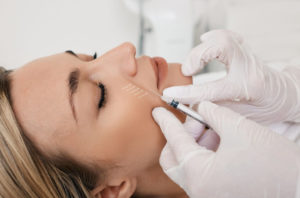When it comes to fixing sagging skin, most people think the only viable option is surgery. But we are here to tell you that professionally administered chemical peels for sagging skin are the way to go. Chemical peels that target sagging skin work to exfoliate dead skin cells from the skin’s surface and smooth out the skin while stimulating collagen and elastin for a more youthful plumpness and less sagging. We have all the answers here if you’re curious about how they work and the best chemical peel for sagging skin.
Do Chemical Peels Help With Sagging Skin?
Yes. Chemical peels help to improve the appearance of sagging skin in the face and neck area by utilizing a unique exfoliating chemical solution that removes the outer layer of dead skin cells and damaged skin. As a result, new skin replaces it, which is fresh, smooth, and less wrinkled with a more natural tautness to it.
Which Type of Chemical Peel is Best for Skin Tightening?
Several different chemical peels are used in skin care. However, the best chemical peel for sagging skin is the one that addresses your specific concerns and is the perfect match for your skin type.
The most commonly used chemical peels include:
Light Chemical Peels
These can consist of glycolic, salicylic, or lactic acid and provide subtle results. They usually treat mild hyperpigmentation, acne, minimal sun damage, and wrinkles.
Medium Chemical Peels
These peels rely on trichloroacetic acid (TCA) peels and treat more severe blemishes, acne, lines, and pigmentation. The peeling process is more powerful than a light peel, so expect more downtime with these peels—anywhere from seven to 10 days. TCA peel concentrations can vary depending on what else it is combined with.
At AdvancedMD Aesthetics, our most popular peels include:
RevePeel Enlighten
This medium-depth skin-lightening peel system consists of an intensive mask treatment and a home care regimen to reduce the appearance of blemishes and discoloration. The kit also comes with hydroquinone and retinol to safely fade dark spots. Patients appreciate the low level of skin irritation compared to other types of chemical peels.
The RevePeel Enlighten treats hyperpigmentation, melasma, blotchy skin, dark spots, enlarged pores, scars, and dullness. It can be repeated several times yearly to achieve the desired brightness level.
PRX Peel
This revitalization skin peel tightens without noticeable exfoliation. The advanced formula consists of trichloroacetic acid (TCA), hydrogen peroxide, and kojic acid. Yet, it is a revolutionary non-peeling peel that improves surgical and acne scars, loose skin, and stretch marks. It also works around the eye area and improves stubborn melasma, fine lines and wrinkles, enlarged pores, and dull-looking skin. In addition, targeting the epidermal layer of skin down to the basal layer can renew the skin without causing any damage.
The PRX Peel is ideal for those who want to firm their skin but can’t afford downtime.
What Is The Most Powerful Type of Chemical Peel?
The most potent type of peel is the deep chemical peel, which uses phenol to exfoliate the skin. Most phenol peels are done under anesthesia and with plastic surgery, like a facelift. The deepest peels also come with the most downtime; most patients opt for those only once.
What Should I Expect After a Chemical Peel to Help With Sagging Skin?
The best chemical peel for sagging skin will likely come with some downtime. That’s because to work its magic, the peel needs to exfoliate away the uppermost layers of skin to stimulate collagen and make a noticeable difference. The skin may appear like it has a sunburn, and there may also be redness, followed by scaling within three to seven days. There may also be some minor skin swelling as the skin heals, along with skin crusting that turns brown and peels off within seven to 14 days following medium peels. You’ll also need to avoid the sun directly after the procedure and for several months to reduce the risk of hyperpigmentation forming.
Will A Chemical Peel Physically Remove Sagging Skin?
Unlike plastic surgery, which physically excises loose, sagging skin from the face and the neck, a chemical peel does not. Since no cutting or incisions are made, the skin remains intact. However, the skin’s texture and tautness improve with a chemical peel because it exfoliates the skin to enhance its texture while boosting collagen and elastin production. Smoother, firmer skin creates a more youthful appearance and more taut skin. After a couple of weeks, the skin should appear to be tighter than it was before. Some clients will be satisfied with their results after a single treatment, but others may opt for multiple treatments over a few months.
Is There Anything I Should Do to Prepare for the Chemical Peel?
Before your peel, it’s best to follow the specific directions given to you by the person performing it. Review your calendar before scheduling a chemical peel and confirm that you have no major events planned because the skin will typically peel for four to ten days with a chemical peel. Although you can wear makeup, peeling skin is sometimes difficult to hide.
Avoiding sun exposure before the procedure is essential, which can compromise the results and inflame the skin. You will likely also be told to stop using retinol, retinoids, or other exfoliating acids for about one week before your treatment to prevent over-exfoliating of the skin.
Can Too Many Chemical Peels Thin Out My Saggy Skin?
No. The best chemical peel for sagging skin won’t thin out your skin or compromise it. Instead, any good chemical peel aims to exfoliate and resurface the skin, helping it rebuild collagen so that the skin appears firmer and more taut. Even after one peel, the skin will appear healthier and less slack.
What Are the Best Ares to Use a Chemical Peel for Sagging Skin?
Since chemical peels stimulate collagen, the skin protein that allows it to be firm, there are many areas where chemical peels can address sagging skin. With age, collagen levels naturally decrease, which causes the skin to sag and be less firm. But a chemical peel can stimulate collagen production because it penetrates the skin, making it tighter and firmer.
Chemical peels are most commonly used on the face, neck, and hands to address signs of aging. Sometimes, they are used in conjunction with other skin rejuvenating treatments to garner the best results.
Do Chemical Peels and Lasers Both Treat Sagging Skin the Same?
Even though both chemical peels and lasers can produce somewhat similar results, each works differently. Lasers use energy to safely wound the skin, while chemical peels rely on acids to exfoliate the skin. Lasers pose more risk and downtime than a chemical peel, but a consultation will determine your best choice.









